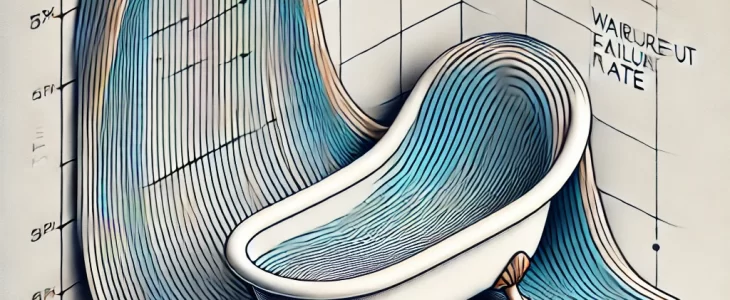

Understanding the Bathtub Curve in Semiconductor Reliability, Testing, and Quality
The bathtub curve is a fundamental concept in reliability engineering, used extensively to describe the life cycle of products, including semiconductors. The curve gets its name from its shape, which resembles the cross-section of a bathtub. It consists of three distinct phases: early failure, constant failure (or useful life), and wear-out failure. This model helps manufacturers and engineers predict and improve the reliability and quality of semiconductor devices through targeted testing and robust design methodologies.
Phases of the Bathtub Curve
- Early Failure Phase:
- Description: Also known as infant mortality, this phase is characterized by a high failure rate immediately after the product is released. These failures are often due to manufacturing defects or other initial issues.
- Testing Methods: Burn-in testing is commonly used during this phase to weed out defective units. This involves operating the devices at elevated temperatures and voltages to accelerate the failure mechanisms. According to KES Systems, burn-in tests are typically performed at temperatures of 125ºC or 150ºC with electrical signals applied to detect early failures.
- Constant Failure Phase:
- Description: Known as the useful life period, the failure rate stabilizes and becomes relatively low and constant. During this phase, random failures occur but are not related to time.
- Testing Methods: During the useful life phase, reliability is ensured through regular quality control tests and monitoring. Highly Accelerated Stress Testing (HAST) is used to simulate long-term operational conditions. HAST subjects semiconductors to high temperatures and humidity to quickly precipitate failures, effectively reducing test times from weeks to days.
- Wear-Out Failure Phase:
- Description: This final phase shows an increasing failure rate as the product approaches the end of its useful life. Failures during this period are typically due to aging and wear-out mechanisms.
- Testing Methods: Life testing and reliability assessments are crucial during this phase. Power temperature cycle (PTC) tests are used to determine the ability of a device to withstand alternating exposures to high and low temperatures, identifying wear-out failures.
Industry Standards
Several industry standards guide the reliability testing of semiconductors:
- JESD22-A110: Describes HAST procedures, focusing on accelerating moisture-related failures.
- JESD22-A118: Provides guidelines for unpowered HAST, emphasizing accelerated temperature and humidity conditions.
- IEC 60068-2-66: Covers environmental testing, particularly the combined effects of high temperature and humidity on electronic devices.
KES Systems’ Expertise in Reliability Testing
KES Systems, a leading provider of burn-in and reliability testing solutions, leverages extensive experience and advanced technologies to ensure the reliability of semiconductor devices. Their services include:
- Burn-In Boards and Systems: KES designs and manufactures high-quality burn-in boards tailored for various semiconductor applications. These boards are crucial for conducting burn-in tests, which are essential for identifying early failures in the production cycle. KES has developed specialized boards for high-temperature burn-in, supporting applications up to well over 200ºC.
- Highly Accelerated Stress Testing (HAST): KES Systems designs HAST boards for numerous platforms, facilitating accelerated testing to rapidly identify potential failures due to humidity and temperature stresses. This testing method significantly reduces the time required compared to traditional methods like Temperature-Humidity-Bias (THB) testing.
- Custom Solutions and Support: KES provides bespoke solutions for unique customer requirements, including custom sockets, passive components, and specialized burn-in chambers. Their engineers offer consultation on best practices, material choices, and design optimizations to ensure high reliability and performance of semiconductor devices.
Practical Applications and Benefits
Implementing the bathtub curve model and associated testing methodologies provides several benefits:
- Improved Product Reliability: By identifying and eliminating early failures through burn-in testing, manufacturers can ensure only robust units proceed to the market.
- Cost Efficiency: Early detection of defects reduces the long-term costs associated with warranty claims and product recalls.
- Enhanced Customer Satisfaction: Reliable products enhance brand reputation and customer trust, leading to increased market competitiveness.
KES Systems’ comprehensive solutions and expertise in burn-in and reliability testing are vital for semiconductor manufacturers aiming to produce high-quality, reliable products. Their adherence to industry standards and innovative testing methodologies ensures that their clients can achieve the highest levels of reliability and performance in their semiconductor devices.
For more detailed information on KES Systems’ services and their role in semiconductor reliability testing, you can visit their official website here.